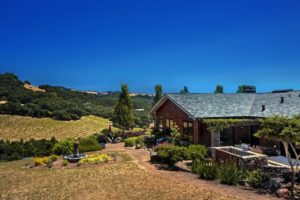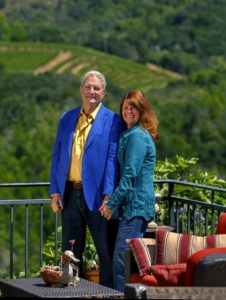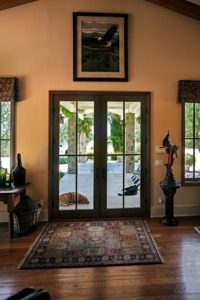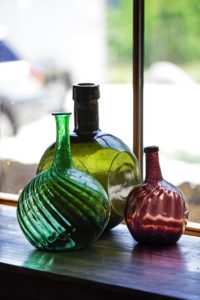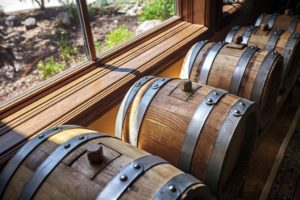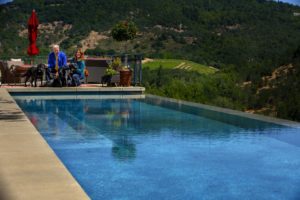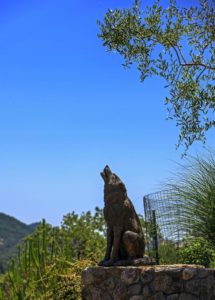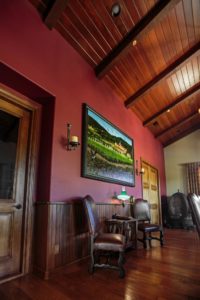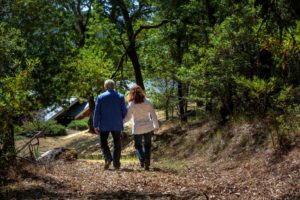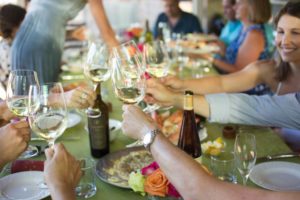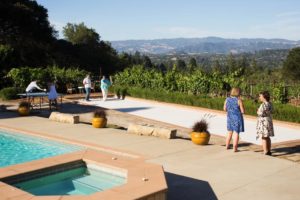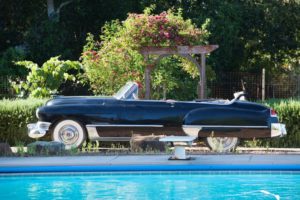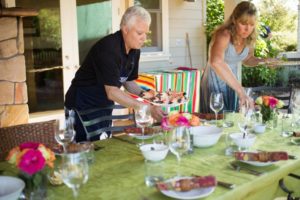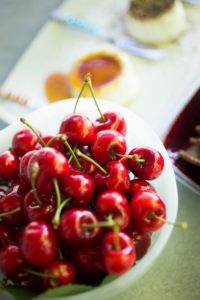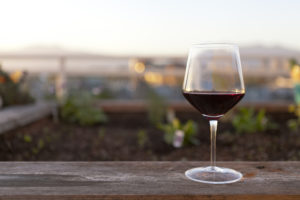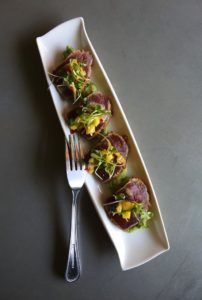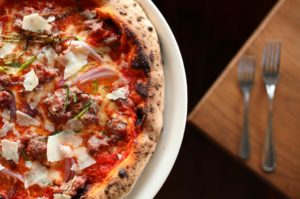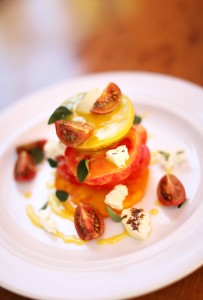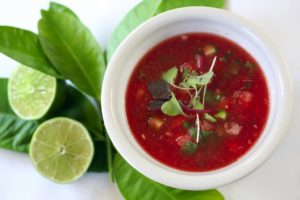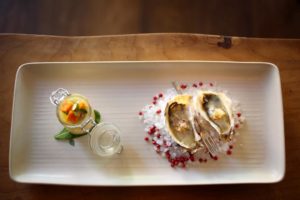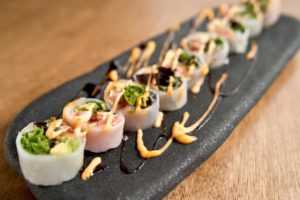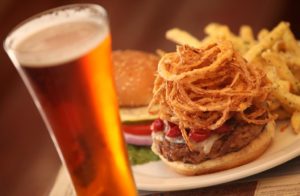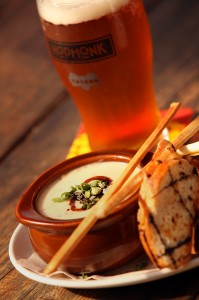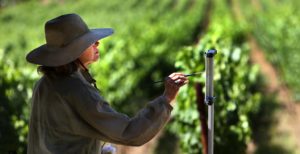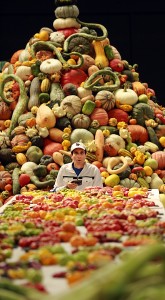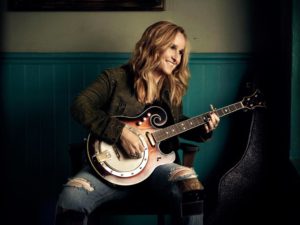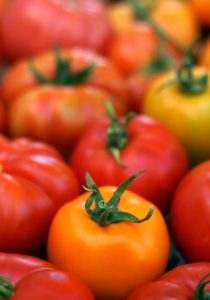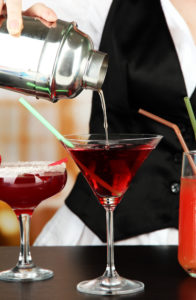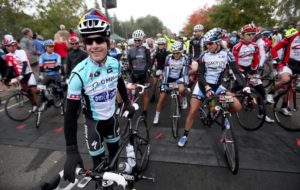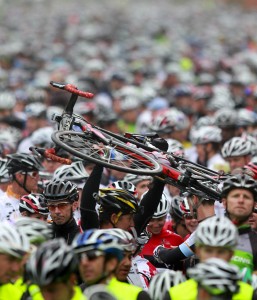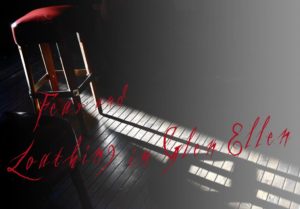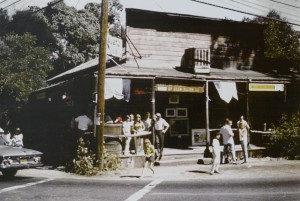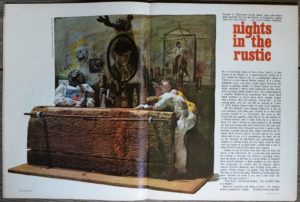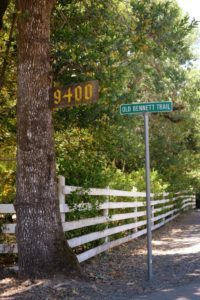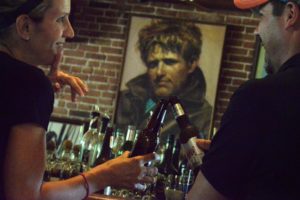Everyone seems to want to be in Wine Country during harvest, the most exciting and beautiful time of the year. There’s a buoyant energy at wineries now, as well as new tasting experiences and tours, many of which take place in the middle of the crush action. Wine writer Virginie Boone recommends these wineries for late summer and fall visits; they are open to the public, typically from 11 a.m. to 4 p.m. Contact the individual tasting room to confirm.
Anaba, 60 Bonneau Road, Sonoma, 707-996-4188, anabawines.com. In the heart of windy Carneros, Anaba welcomes tasters to enjoy its restored farmhouse and remarkable Rhone-variety wines, in addition to vineyard-designated Pinot Noirs and Chardonnays. A good spot for picnics, Anaba offers a wine education experience called Beyond the Label, during which each of its wines is explored in detail; there is also a Salon Tasting of flights of wines.
Benziger Family Winery, 1883 London Ranch Road, Glen Ellen, 707-935-4527, benziger.com. The great folks at Benziger now offer a seated Pinot Noir Experience, a chance to enjoy a guided flight of the winery’s top-notch, cool-climate de Coelo and Signaterra Pinot Noirs with paired bites. The cost is $50 per person, and the experience happens daily at 10:30 a.m. and 2 p.m.; advance reservations are required
Black Stallion Winery, 4089 Silverado Trail, Napa, 707-227-3250, blackstallionwinery.com. Posh and hospitable, Black Stallion offers luxury and comfort in equal measure, with plenty of outdoor seating to enjoy the winery’s Sauvignon Blanc and Chardonnay, and stellar bottlings of Pinot Noir and Cabernet Sauvignon.
Charles Krug-Peter Mondavi Sr. Family Vineyards, 2800 Main St., St. Helena, 707-967-2200, charleskrug.com. Charles Krug, where Peter and Robert Mondavi got their winemaking start, remains an impressive blend of old and new, and its epic Redwood Cellar is an airy place to taste. The Sauvignon Blancs are bright and crisp, the Cabernet Sauvignons elegant. Visitors can enjoy myriad tasting options and tours, and can take a bottle of wine to enjoy on the Great Lawn.
Chimney Rock, 5350 Silverado Trail, Napa, 800-257-2641, chimneyrock.com. Take a 90-minute Tomahawk Vineyard tour and sip winemaker Elizabeth Vianna’s Cabernet Sauvignon while listening to discussions on viticulture and winemaking. Gourmet cheeses provide nourishment ($125/person). Tours leave daily at 10 a.m.; reserve early.
DeLoach Vineyards, 1791 Olivet Road, Santa Rosa, 707-755-3309, deloachvineyards.com. The visitor experience at DeLoach is always a good one, but owner Jean-Charles Boisset can’t help but continue to up the ante, accentuating the celebration of nature here and the bounty of Biodynamic farming, as he has done at Raymond Vineyards in Napa Valley. This time of year, take part in the MFS Blending Experience, a chance to play with Pinot Noir; it’s offered daily by appointment, at 10:30 a.m. or 1:30 p.m.
Frank Family Vineyards, 1091 Larkmead Lane, Calistoga, 800-574-9463, frankfamilyvineyards.com. Frank Family is a popular Napa Valley stop because of its friendly gardens, picnic spots and affordable tasting fees: $20 for a tasting of four wines, from sparkling to Cabernet Sauvignon and Petite Sirah. It also happens to inhabit a historic site, the one-time Larkmead Winery, third-oldest in the valley.
Geyser Peak Winery, 2306 Magnolia Drive, Healdsburg, 707-857-2500, geyserpeakwinery.com. A new home for the timeless winery, Geyser Peak is near downtown Healdsburg; visitors can walk or bike to the new digs. Premier tastings start at $10, reserve tastings at $15, and summertime picnic options and seated wine and cheese pairing packages (by reservation) are available to guests.
Grgich Hills Estate, 1829 St. Helena Highway, Rutherford, 800-532-3057, grgich.com. The mighty Grgich Hills, a wonderful producer of Chardonnay and Cabernet Sauvignon, offers a slew of fine visitor experiences, from barrel tasting every Friday at 2 p.m. to 4 p.m., to seated wine tastings with cheese ($40); a rustic vineyard adventure ($125); and grape stomping ($30, Labor Day to Halloween). On any day, the staff will also order box lunches for visitors to enjoy on the grounds.
Hall Wines, 401 St. Helena Highway, St. Helena, 707-967-2626, hallwines.com. Home to the gigantic silver bunny sculpture, Hall celebrates wine and art, offering the chance to breeze through its winery enjoying works of modern art and sculptures while sampling its exceptionally high-quality wines. Hall also runs a winery in Rutherford that’s more off the beaten track and can be visited too, by appointment, for tours and tastings.
Hamel Family Wines, 15401 Sonoma Highway, Sonoma, 707-996-5800, hamelfamilywines.com. So new that the winery, estate house and wines caves are still under construction, Hamel makes Bordeaux-style wines from four Sonoma Valley estate vineyards. Martha McClellan of Levy & McClellan and Checkerboard Vineyards – and a former associate winemaker at Harlan Estate – makes the wines.
J Vineyards & Winery, 11447 Old Redwood Highway, Healdsburg, 707-431-5400, jwine.com. A glass of bubbly is always a good thing, and this is a well-appointed spot at which to have one, as well as taste J’s Pinot Noirs and Chardonnays. But don’t miss having a sip of Pinot Gris, among its most popular, hot-weather-perfect wines. The J Bubble Room pairs wines with exquisite, locally sourced dishes; chef Erik Johnson is a huge proponent of sourcing locally.
Jordan Vineyard & Winery, 1474 Alexander Valley Road, Healdsburg, 800-654-1213, jordanwinery.com. By appointment, Jordan welcomes visitors for walking tours through its beautiful compound, which includes estate gardens where executive chef Todd Knoll sources a cornucopia of produce for winery meals. Tours and seated tastings are held Monday through Saturday throughout the year.
Littorai, 788 Gold Ridge Road, Sebastopol, 707-823-9586, littorai.com. Nestled in the cool Sebastopol Hills, Littorai offers two tasting options, both by appointment only. The first is a Single Vineyard Tasting of vineyard-designated Pinot Noir and Chardonnay ($25); the second is a tour of the Pivot Estate Vineyard, farmed Biodynamically, followed by a tasting ($40). Littorai winemaker Ted Lemon is among California’s finest winemakers and respected throughout the world.
Markham Vineyards, 2812 St. Helena Highway, St. Helena, 707-963-5292, markhamvineyards.com. Situated in one of the oldest stone buildings in Napa Valley, Markham makes a wide range of wines and offers a taste of four (Sauvignon Blanc, Chardonnay, Merlot and Cabernet Sauvignon) in its daily Rock & Roll Tasting ($15). The on-site art gallery features the work of music photographer Baron Wolman, with lots of shots from Woodstock and the time he spent shooting for Rolling Stone magazine.
Monticello Vineyards, 4242 Big Ranch Road, Napa, 707-253-2802, corleyfamilynapavalley.com. Come to the Corley family’s Napa winery and sit down to a Jefferson House Reserve Tasting ($30) held in the Jefferson House Reserve Room or on the terrace. Dig deep into single-vineyard Cabernet Sauvignon, or sign up to be winemaker for a day ($90), with a two-hour blending session and walk through the vineyards that ends with a tasting of more wines.
Murphy-Goode Winery, 20 Matheson St., Healdsburg, 800-499-7644, murphygoodewinery.com. Recently refreshed, the Murphy-Goode tasting room feels like a remodeled barn, with ample room to relax, play shuffleboard or linger on the back porch. It also houses a vintage photo booth for taking funny pictures in between sips of wine.
Navarro Vineyards and Winery, 5601 Highway 128, Philo, 800-537-9463, navarrowine.com. The wide selection of crisp white wines and bright, mellow reds is worth the drive to Philo in Anderson Valley, where Navarro’s homey picnic grounds inspire taking one’s time. Plenty of picnic goodies are stocked in the tasting room, including co-owner Sarah Cahn Bennett’s fine farmstead goat cheeses, made down the road at Pennyroyal Farms. Tours into the vineyard are led twice a day, by appointment.
Odette Estate, 5998 Silverado Trail, Napa, 707-224-7533, odettewinery.com. PlumpJack’s latest endeavor, Odette Estate, is open daily by appointment for tasting and hosts its popular Secret Cinema movie night Oct. 19. Beginning at 5:30 p.m., it’s a night of food, wine and an old-fashioned drive-in movie ($60/car). The movie is announced the week of the event (that’s the secret part); dressing up is encouraged and Gott’s Food Truck is on hand for the hungry.
Patz & Hall’s Sonoma House, 21200 Eighth St. East, Sonoma, 877-265-6700, patzhall.com. In a well-appointed house in the Carneros region, this chic tasting spot highlights all the delights of Patz & Hall, a specialist in single-vineyard Chardonnay and Pinot Noir. Taste four wines for $25 with truffle nuts, or sit down for a discussion and tasting of six wines with meticulously prepared mini-meals ($50). Chances are the day will start off with a glass of bubbly to open the palate. Recently added is the Terrace Tasting, an intimate tableside tasting of single-vineyard wines with local cheese ($40).
Phillips Hill Winery, 5101 Highway 128, Philo, 707-895-2209, phillipshill.com. Newly opened in Anderson Valley, Phillips Hill resides in a two-story, restored apple-drying barn where tastings are held overlooking the nearby creek. French cheeses and charcuterie are served from the on-site commercial kitchen, a nice accompaniment to the elegant Pinot Noir, Chardonnay and Gewürztraminer made here.
Quintessa, 1601 Silverado Trail, Rutherford, 707-286-2730, quintessa.com. Quintessa has recently built three lovely pavilions overlooking its Dragon’s Hill vineyard block. There, visitors (by appointment) are invited to enjoy a 90-minute immersion into the winery’s Cabernet Sauvignon, from barrel samples highlighting the estate’s 26 distinct vineyard blocks to rare library wines, all paired with local cheeses. The experience lasts 90 minutes and costs $125/person.
Red Car Wine, 8400 Graton Road, Sebastopol, 707-829-8500, redcarwine.com. Red Car makes some of Sonoma’s most exciting cool-climate wines, from crisp Chardonnays to nicely rendered Pinot Noirs and Syrahs. The whimsical labels alone are worth the trip.
Robert Biale Vineyards, 4038 Big Ranch Road, Napa, 707-257-7555, biale.com. A producer of truly elegant vineyard-designated Zinfandel and Petite Sirah, Biale works with a wide range of historic vineyards throughout Napa and Sonoma. Enjoy the outdoor patio and ponder the views of the surrounding vineyards as you taste through a lineup of fine wines, including the winery’s signature Black Chicken Napa Valley Zin, an ode to bootlegging in Prohibition days.
Rodney Strong Vineyards, 11455 Old Redwood Highway, Healdsburg, 800-678-4763, rodneystrong.com. For a comprehensive taste of Sonoma County with expansive views of vines, look no further than Rodney Strong, which offers an estate wine tasting daily as well as the option to try single-vineyard and reserve wines. From its Alexander Valley Cabernets to Davis Bynum Pinot Noirs and Chardonnays, there’s a lot to like here. Outdoor picnics are also in order, daily on the winery’s lawn or vineyard terrace, with picnic items for purchase inside.
Roederer Estate, 4501 Highway 128, Philo, 707-895-2288, roederestate.com. Take a tour ($6) of the Anderson Valley home of Roederer Estate and see how some of America’s best sparkling wines are made, then sit on the balcony and breathe in the cool coastal air. Picnics for two ($25) can be ordered ahead.
Rutherford Hill Winery, 200 Rutherford Hill Road, Rutherford, 707-963-1871, rutherfordhill.com. Tasting flights and cave tours happen daily at Rutherford Hill, a lovely tasting room with beautiful views of Napa Valley. But take advantage of the Saturday Blend Your Own Merlot Seminar if you can, a two-hour session that includes wine tasting and a cave tour, followed by the chance to blend, bottle and label a wine of one’s own ($105/person).
Schramsberg Vineyards, 1400 Schramsberg Road, Calistoga, 800-877-3623, schramsberg.com. Among the first in California to specialize in sparkling wine, Schramsberg occupies hallowed, historic ground and is home to the oldest hillside vineyards in Napa Valley and some of the first caves dug for storing and aging wine. Take a tour by appointment, and don’t miss the Mirabelle Brut Rosé and other gorgeous sparklers before moving on to taste the J. Davies Estate Cabernet Sauvignon and Pinot Noir.
Seghesio Family Vineyards, 700 Grove St., Healdsburg, 707-433-3579, seghesio.com. Through mid-October, this mighty Zinfandel producer operates Cafe La Brezza, a place to gather and enjoy small plates of Mediterranean-inspired, seasonally sourced foods such as oven-roasted shrimp, white bean salad and ribs with wines by the glass.
Silverado Vineyards, 6121 Silverado Trail, Napa, 707-257-1770, silveradovineyards.com. Perched atop a hill off the Silverado Trail, this is a quiet place to visit and enjoy terrace views, plus many tasting options on offer. The Saddleblock Tasting is a good one this time of year; it includes a tour of the Saddleblock vineyard with wines and appetizers ($75/person). Limited to four guests.
Tasting Room on the Green, 9050 Windsor Road, Windsor, 707-687-5089. A partnership of Deux Amis and Mutt Lynch wineries, this dog-friendly spot pours Zinfandel, Petite Sirah and a red blend called Ducks a Miss, made by Deux Amis winemaker Phyllis Zouzounis. Mutt Lynch wines include Sauvignon Blanc, Merlot and a limited series of vineyard-designate wines under the Man’s Best Friend imprimatur.
VJB Vineyards & Cellars, 60 Shaw Ave., Kenwood, 707-833-2300, vjbcellars.com. In an Italian-inspired, courtyard-centered villa in the heart of Sonoma Valley, VJB serves steamy coffee and pastries in the morning; panini, pasta and pizza during the day; and samples of its Italian-inspired wines. The winery also stocks co-proprietor Maria Belmonte’s line of sauces, pestos and tapenades, and houses a shop for gelato and specialty chocolates.




